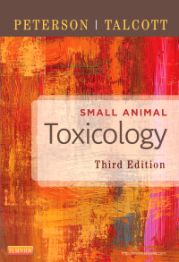Small Animal Toxicology, 3rd Edition
Diagnose and determine treatment for toxic exposures in small animals with this quick reference! Small Animal Toxicology, 3rd Edition covers hundreds of potentially toxic substances, providing the information you need to manage emergency treatment and prevent poisonings in companion animals. To help you identify an unknown poison, this guide provides a list of potential toxins based on clinical signs or symptoms. It also includes a NEW color insert with 85 full-color photographs of toxic plants and of lesions associated with various poisonings. Written by respected veterinarian Michael E. Peterson and board-certified veterinary toxicologist Patricia A. Talcott, along with a team of expert contributors, this edition covers a wide variety of topics including toxicodynamics, toxicokinetics, effective history taking, recognizing clinical signs of toxic exposures, managing emergencies, and supportive care of the poisoned patient.
Diagnose and determine treatment for toxic exposures in small animals with this quick reference! Small Animal Toxicology, 3rd Edition covers hundreds of potentially toxic substances, providing the information you need to manage emergency treatment and prevent poisonings in companion animals. To help you identify an unknown poison, this guide provides a list of potential toxins based on clinical signs or symptoms. It also includes a NEW color insert with 85 full-color photographs of toxic plants and of lesions associated with various poisonings. Written by respected veterinarian Michael E. Peterson and board-certified veterinary toxicologist Patricia A. Talcott, along with a team of expert contributors, this edition covers a wide variety of topics including toxicodynamics, toxicokinetics, effective history taking, recognizing clinical signs of toxic exposures, managing emergencies, and supportive care of the poisoned patient.
New to this edition
- 20 new chapters have been added
- New topics include a list of toxicants affecting body systems, management of toxins in pregnancy, diagnostic toxicology, bacterial toxins, and cosmetic/toilet articles
- Snake-bite injuries are treated in two separate, expanded chapters: Pit Vipers and Coral Snakes
- Section on pharmaceuticals includes bromides, anticonvulsants, tricycle antidepressants, monoamine oxidize inhibitors, B-adrenergic toxicities, and vitamins A and D
- Additional specific toxicants are covered, including Amitraz, hydramethylon, ethanol, mercury, toad toxins, poisonous frogs, salamanders, newts and venomous arthropods• Additional specific toxicants are covered, including Amitraz, hydramethylon, ethanol, mercury, toad toxins, poisonous frogs, salamanders, newts and venomous arthropods.
Key Features
- Comprehensive coverage of toxins/poisons includes the full range of substances from acetaminophen to zinc, including home products, prescription medicines, recreational drugs, and more.
- Guidelines to evaluation, diagnosis and treatment include examinations of the source, toxic dose, toxicokinetics, clinical signs, minimum database, confirming tests, treatment progress and differential diagnosis for each specific toxicant.
- Coverage of common poisonous substances includes grapes and raisins, nicotine, mercury, mushrooms, Christmas-time plants, and snake and spider venoms.
- Toxicological Concepts section provides information on toxicologic principles such as history taking, providing supportive care, and managing emergency treatment.
- General Exposures section addresses nontraditional toxicology such as indoor environmental air, pesticides, pharmaceuticals, and toxicities in pregnant and lactating animals.
- Miscellaneous Toxicant Groups section covers commonly encountered specific toxicants, the proper use of diagnostic laboratories, use of human poison control centers, and antidotes for specific toxins.
- More than 50 international contributors provide up-to-date, authoritative advice on treating poisonings and intoxications.
Author Information












